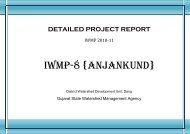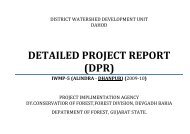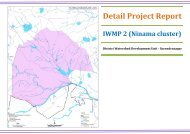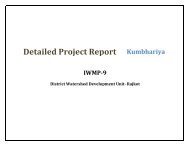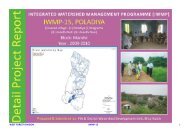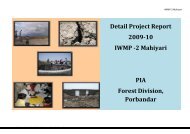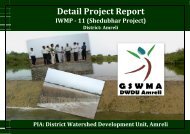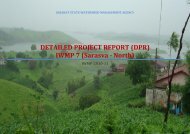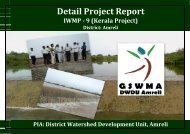Detailed Project Report - Commissionerate of Rural Development ...
Detailed Project Report - Commissionerate of Rural Development ...
Detailed Project Report - Commissionerate of Rural Development ...
You also want an ePaper? Increase the reach of your titles
YUMPU automatically turns print PDFs into web optimized ePapers that Google loves.
District Watershed <strong>Development</strong> Unit - Jamnagar<br />
Dam: Percolation dams are constructed for recharging groundwater. Such structures are usually made on the upper part <strong>of</strong> the catchment area.<br />
Water stored here percolates to wells and tubewells located in the lower part <strong>of</strong> the catchments. Such dams can also be made in the immediate<br />
upstream portion <strong>of</strong> wells and tubewells. Depending on the capacity <strong>of</strong> the dam and duration <strong>of</strong> water storage, the dam can have secondary<br />
benefits (such as pisciculture) that are vital for the livelihood security <strong>of</strong> marginal farmers and landless laborers.<br />
2) Irrigation/Percolation dam<br />
a) Irrigation Dam: Such dams can be constructed to meet two different kinds <strong>of</strong> demands.<br />
<strong>of</strong> storing water during the rainy season to be used for irrigation in the post-monsoon period.<br />
<strong>of</strong> providing protective irrigation during dry spells within the rainy season. Most parts <strong>of</strong> India typically receive rainfall between<br />
June and September, very intensely within a few hours and a few days. The number <strong>of</strong> rainy days does not average more than<br />
40-50. Moreover, rains are extremely erratic, <strong>of</strong>ten characterized by late onset and early withdrawal. Prolonged dry spells during<br />
the rainy season, resulting in agricultural droughts, are also frequent. Hence, the kharif crop needs to be drought-pro<strong>of</strong>ed through<br />
'protective' irrigation, applied to overcome accumulated soil moisture deficits within the rainy season. Such structures are<br />
especially important in areas which are poor in groundwater resources and which do not have access to canal irrigation. Such areas<br />
form about half <strong>of</strong> India's agricultural area.<br />
b). Percolation Tank: Percolation dams are constructed for recharging groundwater. Such structures are usually made on the upper part <strong>of</strong> the<br />
catchment area. Water stored here percolates to wells and tube wells located in the lower part <strong>of</strong> the catchment. Such dams can also be made in the<br />
immediate upstream portion <strong>of</strong> wells and tube wells. Depending on the capacity <strong>of</strong> the dam and duration <strong>of</strong> water storage, the dam can have<br />
secondary benefits (such as pisciculture) that are vital for the livelihood security <strong>of</strong> marginal farmers and landless labourers.<br />
3) Farm bund<br />
Farm bunds are constructed on agricultural land with the aim <strong>of</strong> arresting soil erosion and improving the soil moisture pr<strong>of</strong>ile. Ideally, bunds on<br />
farms should be made on the contour line. But this creates several problems for farmers. Contour bunds divide the field into irregular sections. In<br />
<strong>Detailed</strong> <strong>Project</strong> <strong>Report</strong> – IWMP-1 (Patan )



